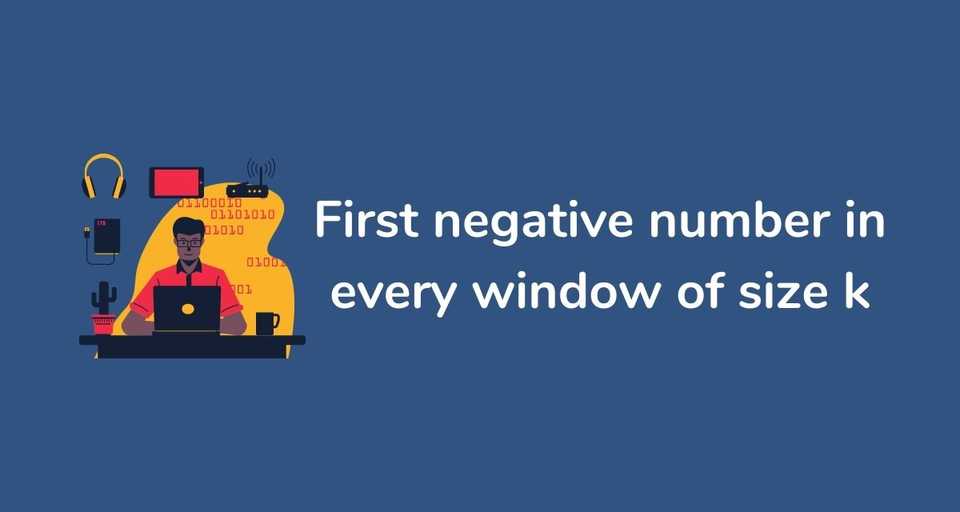Problem statement
Given an array of integers a, and a positive integer k, find the first negative integer for each and every window (contiguous subarray) of size k. If a window does not contain a negative integer, then print 0 for that window.
Example 1
Input: a[] = {-5, 1, 2, -6, 9}, k = 2
Output : -5 0 -6 -6
Explanation: First negative integer in every window of size 2
{-5, 1} = -5
{1, 2} = 0 (does not contain a negative integer)
{2, -6} = -6
{-6, 9} = -6Example 2
Input : a[] = {10, -1, -5, 7, -15, 20, 18, 24} , k = 3
Output : -1 -1 -5 -15 -15 0
Explanation: First negative integer in every window of size 3
{10, -1, -5} = -1
{-1, -5, 7} = -1
{-5, 7, -15} = -5
{7, -15, 20} = -15
{-15, 20, 18} = -15
{20, 18, 24} = 0 (does not contain a negative integer)Solution
Brute force
The naive brute force approach is to run two for loops to find the first negative number in every subarray of size k.
The outer loop runs for every index i of the array and the inner loop explores the next k elements to find the first negative number in the subarray (i to i+k).
The time complexity for this algorithm is O(n*k).
import java.util.Scanner;
class FirstNegativeNumber {
private static int[] findFirstNegativeNumberInSubarrayOfSizeK_BruteForce(int[] a, int k) {
int n = a.length;
int[] firstNegativeNumbers = new int[n - k + 1];
int idx = 0;
for(int i = 0; i <= n-k; i++) {
int firstNegativeNum = 0;
for(int j = i; j < i+k; j++) {
if(a[j] < 0) {
firstNegativeNum = a[j];
break;
}
}
firstNegativeNumbers[idx++] = firstNegativeNum;
}
return firstNegativeNumbers;
}
public static void main(String[] args) {
Scanner keyboard = new Scanner(System.in);
int n = keyboard.nextInt();
int[] a = new int[n];
for (int i = 0; i < n; i++) {
a[i] = keyboard.nextInt();
}
int k = keyboard.nextInt();
keyboard.close();
int[] firstNegativeNumbers = findFirstNegativeNumberInSubarrayOfSizeK_BruteForce(a, k);
for (int i = 0; i < firstNegativeNumbers.length; i++) {
System.out.print(firstNegativeNumbers[i] + " ");
}
System.out.println();
}
}Sliding Window
If you closely observe the way we calculate the first negative number in each subarray of size k in the brute force algorithm, you will realize that we are doing repetitive work. Let’s consider the first example:
Input: a[] = {10, -1, -5, 7, -15, 20, 18, 24}, k = 3In the brute force approach, we first find the first negative number in the subarray {10, -1, -5}, then we move to the next subarray and find the first negative number in the subarray {-1, -5, 7}. Notice that there is an overlap between both the subarrays:
10 -1 -5
-1 -5 7So, we’re exploring the overlapping part ({-1, -5}) twice. Can we explore the overlapping subarray only once and reduce the repetitive work? Yes, and this hints us towards using the Sliding window pattern.
Sliding window pattern
- Consider each subarray of size
kas a sliding window. - Initialize two variables
windowStartandwindowEndpointing to the first element of the array. These variables define the bounds of our sliding window. The initial window size is1. - Initialize a FIFO queue that stores the negative numbers in the current window in a First-in-First-Out order.
- Iterate over the array moving
windowEndforward by one element in each iteration.- If the new element pointed by
windowEndis negative, then add it to the queue. - If the window size hits to
k(windowEnd-windowStart+1 == k), then- Find the first negative number in the current window by getting the first element from the queue and store it in the result.
- If the queue is empty, that means the current window (current subarray) did not have any negative number, so store
0in the result. - Now we need to slide the window ahead. So we need to discard the element at
windowStartout of the window. To do this -- Check if the first element in the queue is equal to the element at
windowStart, if yes then remove it from the queue since it is going out of the window. - Increment
windowStartto slide the window ahead.
- Check if the first element in the queue is equal to the element at
- If the new element pointed by
import java.util.LinkedList;
import java.util.Queue;
import java.util.Scanner;
class FirstNegativeNumber {
private static int[] findFirstNegativeNumberInSubarrayOfSizeK(int[] a, int k) {
int n = a.length;
int[] firstNegativeNumbers = new int[n - k + 1];
int idx = 0;
Queue<Integer> q = new LinkedList<>();
int windowStart = 0;
for (int windowEnd = 0; windowEnd < n; windowEnd++) {
if (a[windowEnd] < 0) {
q.add(a[windowEnd]);
}
if (windowEnd - windowStart + 1 == k) { // Calculate result and Slide the window
if (q.isEmpty()) {
firstNegativeNumbers[idx++] = 0;
} else {
int num = q.peek();
firstNegativeNumbers[idx++] = num;
// Remove a[windowStart] from the queue since we need to slide the window now.
// But only if it was added to the queue previously
if (num == a[windowStart]) {
q.remove();
}
}
windowStart++; // Slide the window ahead
}
}
return firstNegativeNumbers;
}
public static void main(String[] args) {
Scanner keyboard = new Scanner(System.in);
int n = keyboard.nextInt();
int[] a = new int[n];
for (int i = 0; i < n; i++) {
a[i] = keyboard.nextInt();
}
int k = keyboard.nextInt();
keyboard.close();
int[] firstNegativeNumbers = findFirstNegativeNumberInSubarrayOfSizeK(a, k);
for (int i = 0; i < firstNegativeNumbers.length; i++) {
System.out.print(firstNegativeNumbers[i] + " ");
}
System.out.println();
}
}